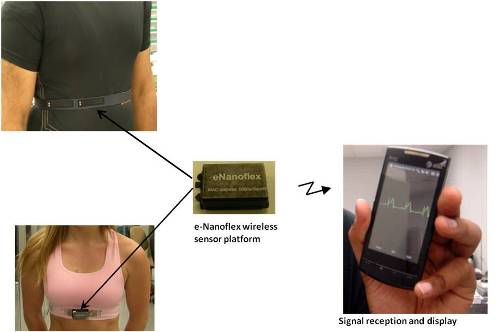A team of engineers from the University of Arkansas has designed a wireless health-monitoring system meant for gathering critical patient information and communicating that information to a hospital, physician or the patient.
 e-Nanoflex wireless sensor platform
e-Nanoflex wireless sensor platform
The newly developed systems comprise a set of nanostructured, textile sensors incorporated into a traditional sports bra for women as well as sports vest for men. The sensors, through a lightweight, wireless module that clasps onto these clothes, inform system software that rests upon a smart phone to gather information, consolidate it and dispatch it over a number of wireless networks.
The new system monitors body temperature, blood pressure, oxygen consumption, respiratory rate, some neural activity and the readings furnished by a standard electrocardiograph (ECG), including the potency to show inverted T waves that point out the beginning of cardiac arrest. Since the system does not need any extra accessories or a cuff to measure blood pressure, it can replace standard blood-pressure monitors.
The sensors incorporated in the system include conducting textile nanosensors and gold nanowires. They are made up of gold nano-electrodes assembled on a substrate. Since the textile sensors are sewn into the bra material, they do not require gel or conventional sticky electrodes for fixing them.
Electrical signals and physiological data collected by the sensors are transmitted to the snap-on wireless module and the contents are stored in a plastic box. Data gathered from the sensors are then streamed to hand-held devices and cell phones. Athletes can watch all signs and other metrics with a help of a cell phone. The software contains filtering algorithms to reduce problems caused due to movement of the device during exercise in order to present clear data. With the help of the software, users can see all data on one screen in a cell phone or a computer. The software also contains a global positioning system to track the exact longitude and latitude of the athlete or patient.
Findings on the e-bra have not yet been published by Vijay Varadan, but the results on the monitoring system were published by him in the Journal of Nanotechnology in Engineering and Medicine. Varadan has named the system as e-Nanoflex Sensor System.